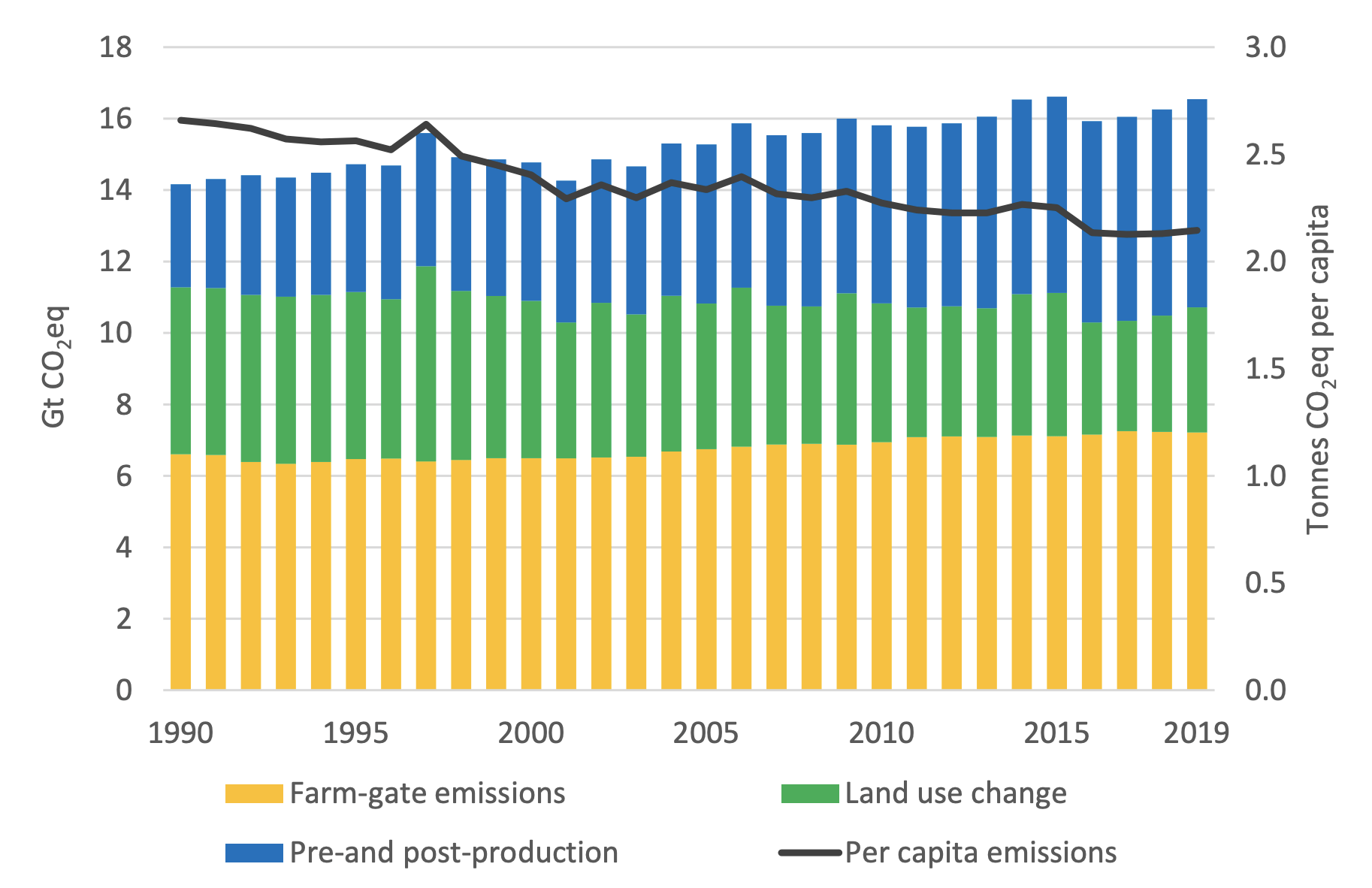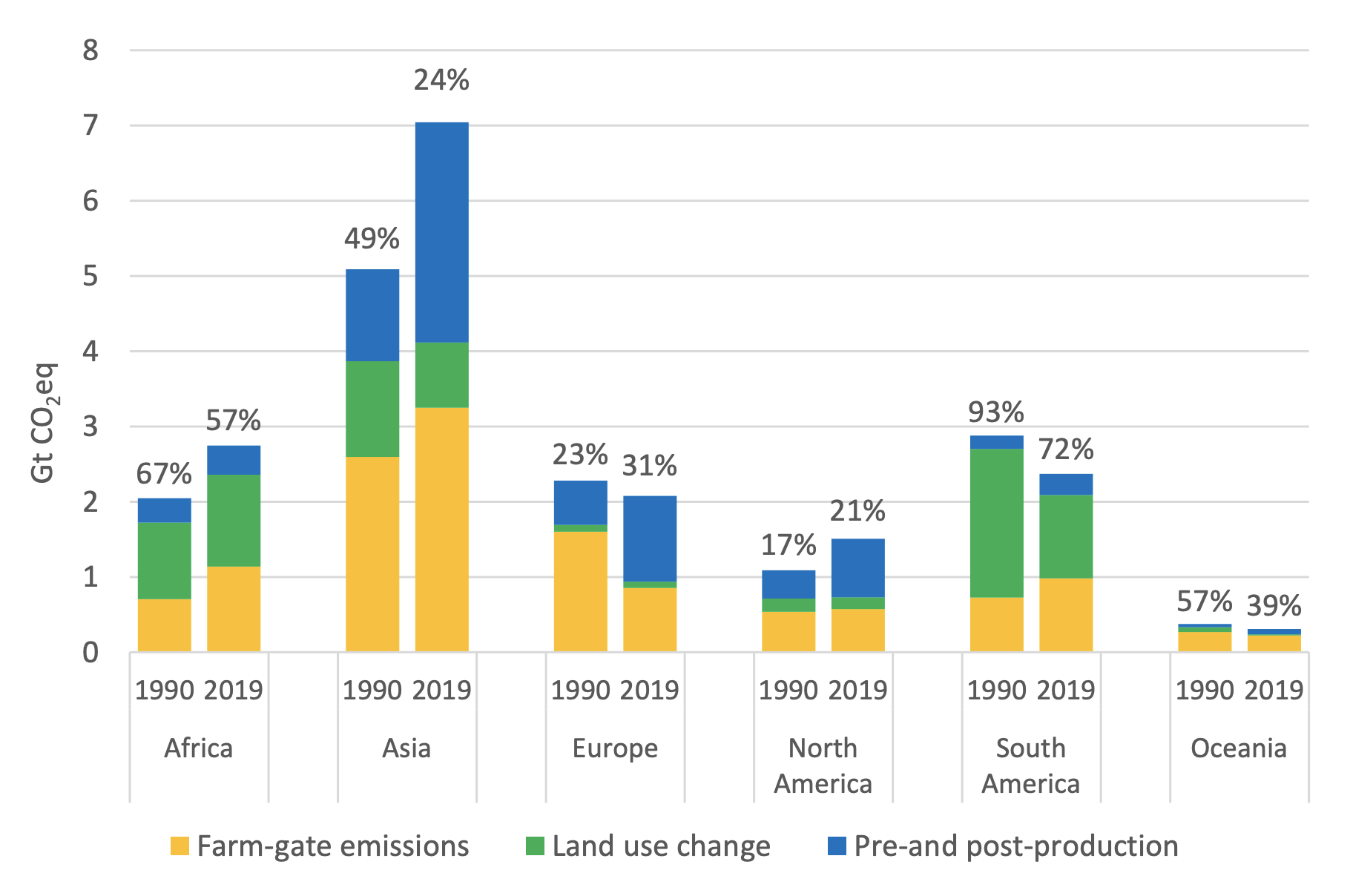A new study from the UN Food and Agriculture Organization (FAO) indicates that the supply chain is the fastest-growing source of greenhouse gas (GHG) emissions from global food systems, outpacing agricultural activity and land use changes.
Released in pre-print yesterday at the COP26 UN Climate Change Conference in Glasgow, UK, the paper analyzes measurements of GHG emissions — including carbon dioxide, methane, and nitrous oxide — from 236 countries between 1990 and 2019. The data was drawn from the FAO’s own FAOStat database.
The world’s agrifood systems were responsible for 31% — 16.5 billion metric tons — of total “anthropogenic” GHG emissions by carbon dioxide equivalents (CO2eq) in 2019, according to the study. That represents a 17% increase from 1990 (the global population has grown by around 45% over the same timeframe, according to World Bank figures.)
World total anthropogenic emissions flows from IPCC-defined sectors to agrifood systems and non-food sectors, 2019 (billion tons CO2eq)

Of those 16.5 billion tons of emissions, the largest share — 7.2 billion tons, or 44% — came from within the farm gate, including crop and livestock production processes and on-farm energy use. Emissions from this part of the agrifood lifecycle have increased by 9% since 1990.
Land use change — such as deforestation to create cropland, and peatland degradation — accounted for 3.5 billion tons (21% of agrifood’s total emissions), representing a 25% decrease since 1990.
So where is most of the growth in food-related GHG emissions coming from?
The FAO study found that 5.8 billion tons (35% of agrifood’s total) in 2019 came from supply chain factors: pre- and post-production processes including manufacturing of fertilizers, food processing, packaging, transport, retail, household consumption, and food waste disposal.
Between 1990 and 2019, food systems’ contribution to overall GHGs was “largely driven by a doubling of emissions” from these supply chain processes, the FAO paper says.
Global agrifood system GHG emissions by lifecycle stage (billion tons CO2eq) and per capita emissions (tons CO2eq), 1990-2019

Moreover, while agriculture remains a bigger contributor to food-related emissions at the global level, it has already been overtaken by the pre- and post-production supply chain across “Annex I” advanced economies; while the supply chain’s input has doubled in “non-Annex I” emerging markets. China and the EU are among the territories where supply chain factors are already the biggest component of agrifood emissions.
In Asia, the world’s most populous region by far and the leading source of agrifood emissions, the supply chain component has almost tripled since 1990 – growing faster than in any other region.
Agrifood systems emissions by region and lifecycle stage (billion tons CO2eq) and share of total regional GHG emissions (%), 1990-2019

Digging down into specific areas within the three lifecycle stages, deforestation was the largest single source of agrifood-related GHG emissions, at 3.06 billion tons CO2eq. This was followed by livestock enteric fermentation (2.82 billion tons), livestock manure (1.32 billion tons), household consumption (1.31 billion tons), food waste disposal (1.31 billion tons), on-farm use of fossil fuels (1.02 billion tons), and food retail (932 million tons) – further highlighting the contribution of pre- and post-production supply chain factors to the food systems’ total.
“The most important trend over the 30-year period since 1990 highlighted by our analysis is the increasingly important role of food-related emissions generated outside of agricultural land, in pre- and post-production processes along food supply chains, at all scales from global, regional, and national,” FAO senior statistician Francesco Tubiello said in a statement.
“This has important repercussions for food-relevant national mitigation strategies, considering that until recently these have focused mainly on reductions of non-CO2 within the farm gate and on CO2 from land use change.”
Companies developing tech-driven solutions for the agrifood supply chain raised $3.1 billion in investment during the first six months of this year, according to AgFunder data [disclosure: AgFunder is AFN‘s parent company.]
Midstream Technologies — an AgFunder-defined category covering logistics and transport, food processing, cold chain storage, food waste mitigation, and food safety and quality testing — was the second highest-funded agrifoodtech subsector in H1 2021 after eGrocery.




